In the summer of 1978, revolution was rumbling across my country, Iran.
Sitting in the living room of our family home in Tehran, my father stared out of the window
into the beyond, and said to me “it’s all over, nothing will be the same again.”
— Christiane Amanpour
All Images © David Burnett
EXCERPTED FROM THE BOOK:
Part One:
The King's Last Days
December 26, 1978 — January 16, 1979
DAY 1 — DECEMBER 26, 1978 Back in New York I’d gotten the name of Time’s stringer in Tehran: Parviz Raein. He’s the Tehran AP bureau chief, too, and runs their office out of his house, a couple of miles from the Intercontinental Hotel. In his late 40s, balding with a mustache, Parviz is elegant, gracious, and very well connected. The Associated Press folks always know what’s happening from day to day; they have tipsters everywhere. In fact, a few minutes after I show up, the phone rings. When Parviz puts it down, his manner is urgent. “A demonstration near Shahyad Square has become violent.” Since my arrival in Tehran on yesterday’s morning flight from Karachi, it’s been clear that things are starting to fall apart here. The airport was virtually empty. No customs, no immigration, no border police with badges or lapel pins—no nothing. I entered the country without even getting my passport stamped. |
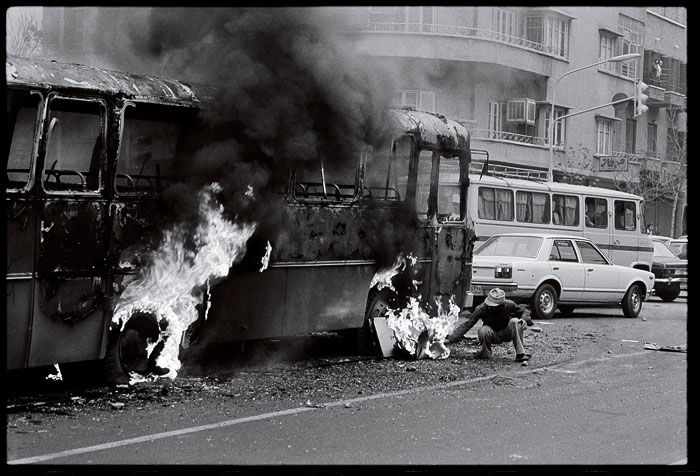
An anti-Shah demonstrator sets a bus afire. Downtown Tehran, December 26, 1978
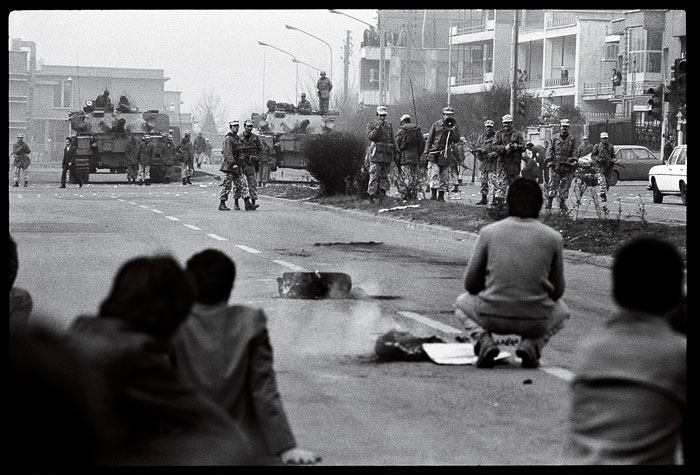
Demonstrators face off against the army. Tehran, December 27, 1978
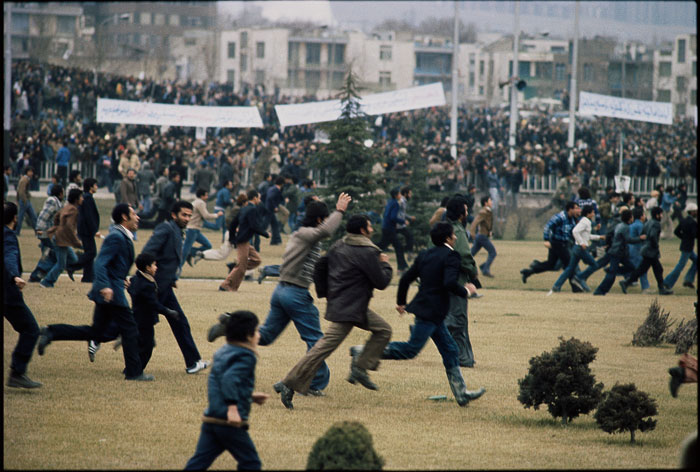
Anti-Shah demonstrators in 24 of Esfand Square on the run after the army opens fire. Tehran, December 27, 1978
DAY 2 — DECEMBER 27, 1978 ...I join the marchers. Despite being protected by the soldiers, many are carrying posters of Ayatollah Khomeini and chanting “Allah akbar.” Then, as we approach 24 of Esfand Square, there’s a sudden loud burst of automatic gunfire and everyone runs. In all directions, I see people jump for cover behind trees or cars, pressing themselves flat against the ground. More soldiers arrive. They’re immediately jumped by the demonstrators. I focus on one who’s been grabbed. I can’t tell if the protestors are trying to get him to drop his gun and join them, or preparing to lynch him. After a few minutes, though, he squirms away, no shots fired. Six or seven people carry a wounded man up the road away from the square and set him on the back of a motorcycle to get him to the hospital. People huddle in the street. Soldiers throw tear gas. The crowd disperses for a minute or so, then slowly reforms. I’ve covered scores of political demonstrations in France, antiwar marches in the U.S., even a few protests in Vietnam during the 1972 presidential elections. But this is the first time I’ve seen a street march end in gunfire. For me, this is the story’s “baptism of fire,” the moment I realize it isn’t another PTA meeting, some little local event about to pass without notice. This is a big deal. And I’m going to be part of it. |
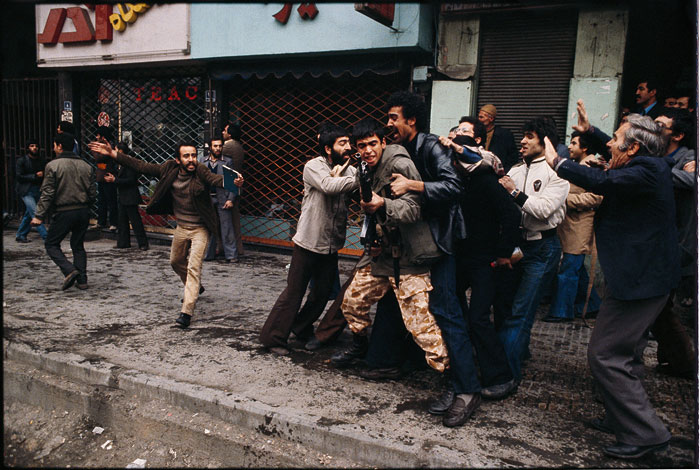
A young soldier is seized by demonstrators in 24 of Esfand Square. Tehran, December 27, 1978
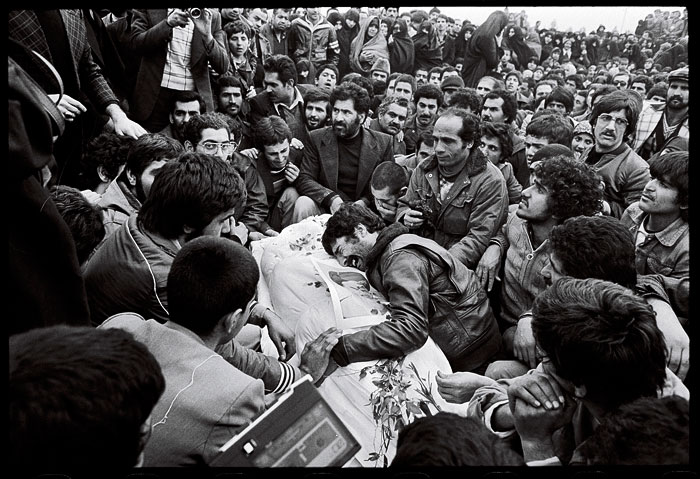
Mourners in Tehran’s main cemetery during the funerals for those killed the day before. December 28, 1978
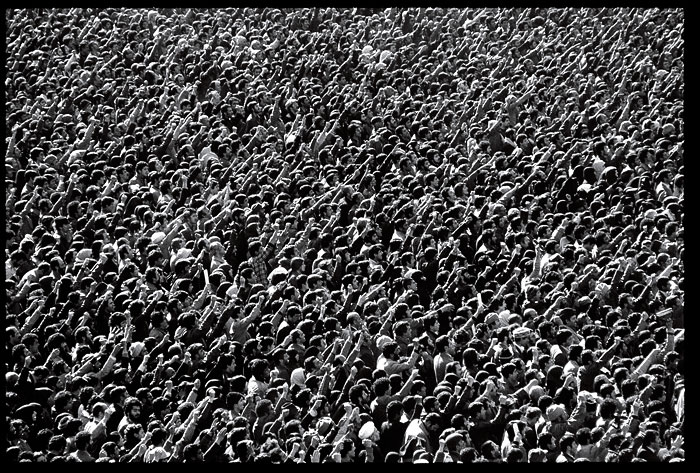
Anti-Shah crowd of demonstrators near Tehran University. January 13, 1979
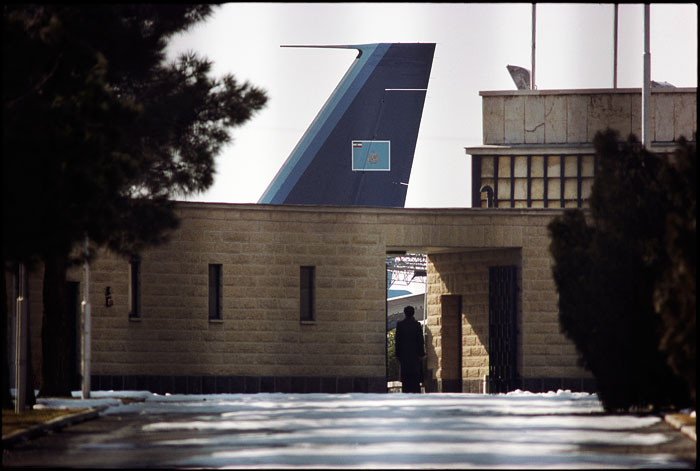
The tail of the Shah’s Boeing 707 taxis down the runway, taking the monarch into exile. January 16, 1979
Part Two:
After the Fall
January 16, 1979 — January 31, 1979
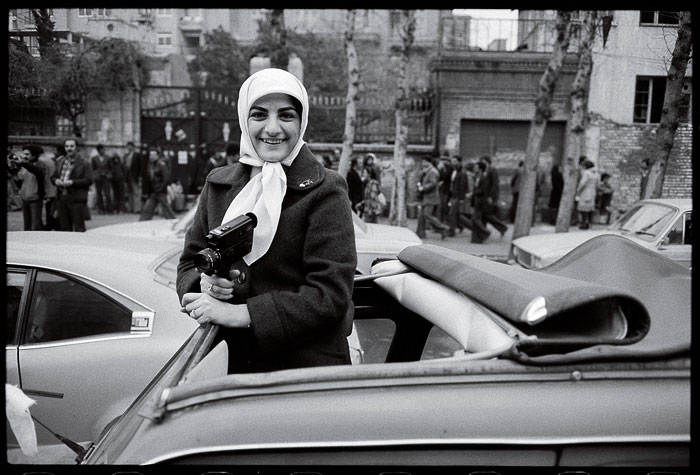
Iranians celebrate the Shah’s departure. Tehran, January 16, 1979
DAY 22 — JANUARY 16, 1979 Word that the Shah has left spreads quickly. Within an hour, the same people who have been rallying against him are out in the street, cheering and surging and waving and mugging for the camera. Many hold up rials, the Iranian currency, with the Shah’s picture torn out. A traffic jam of cars and buses blare their horns and jubilant crowds run through the street with their posters of Khomeini. For the first time in days, many of the faces in the crowds are smiling. In Mordad Square, a statue of a farmer and workers put up by the Shah is toppled. In Shahyad Square, another statue, of the Shah’s father, Reza Pahlavi, is pulled down and dragged through the streets. The crowd tries to pull it up to a highway overpass using a shovel, but it doesn’t work, and the statue lies there, lifeless. As night falls, waves of marauders, suddenly unrestrained by curfews, roam around in groups, burning posters and effigies of the Shah and jumping on the downed statues. Because of the curfew, it’s probably the first time I’ve shot at night since I got to Iran, and there is a furtive, electric feeling to it—fleeting moments when the revelers are suddenly frozen in the light of my strobe or the headlights of passing cars. |
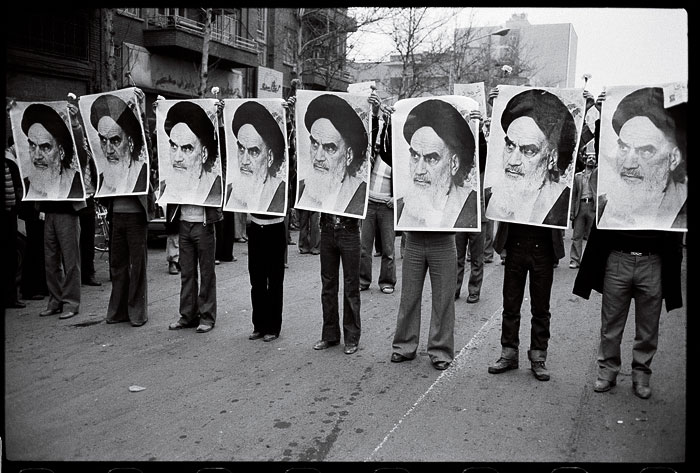
Marchers hold aloft posters of the Ayatollah Khomeini after the Shah’s departure. Tehran. January 16, 1979
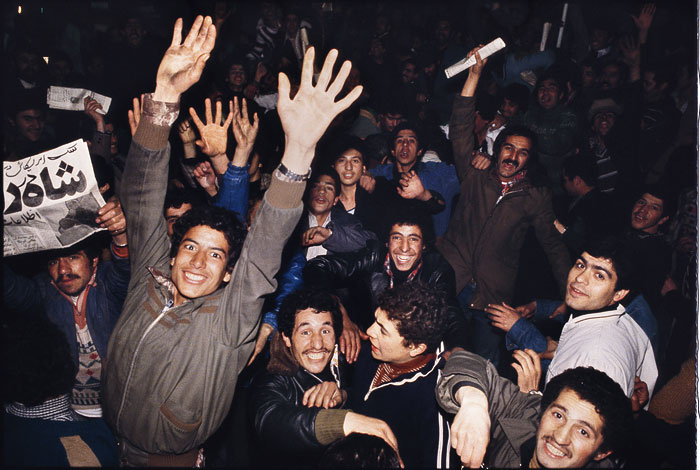
Celebrations continue all night in the capital, after the departure of the Shah. Tehran, January 16, 1979
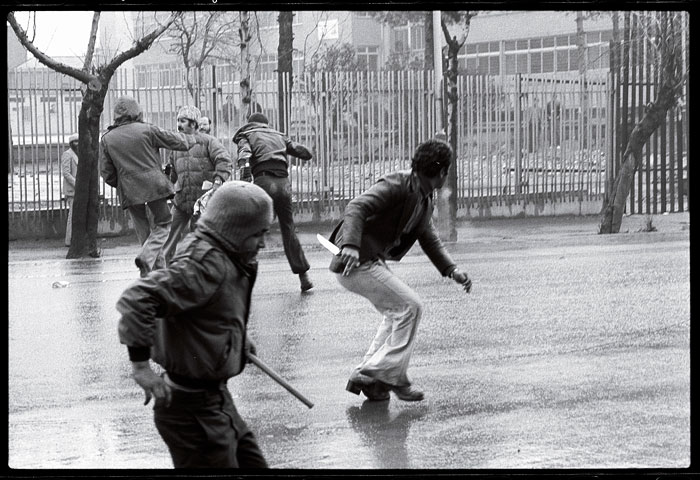
Pro-Khomeini supporters attack “Pro-Constitutionalists” Shah supporters. Tehran, January 24, 1979
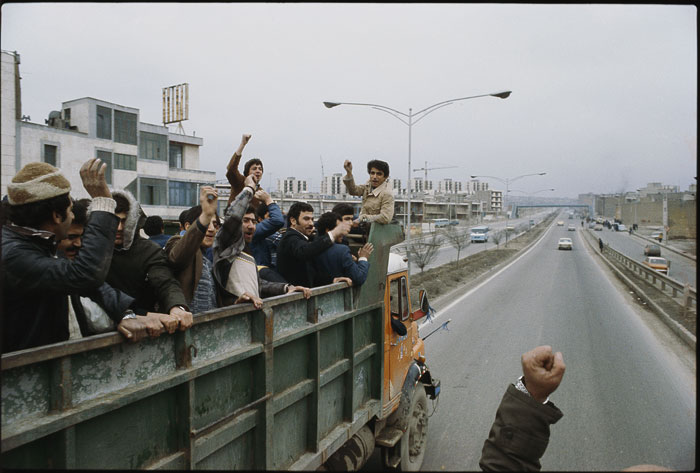
Khomeini supporters en route towards Shahyad Square from the outskirts of the capital. Tehran, January 26, 1979
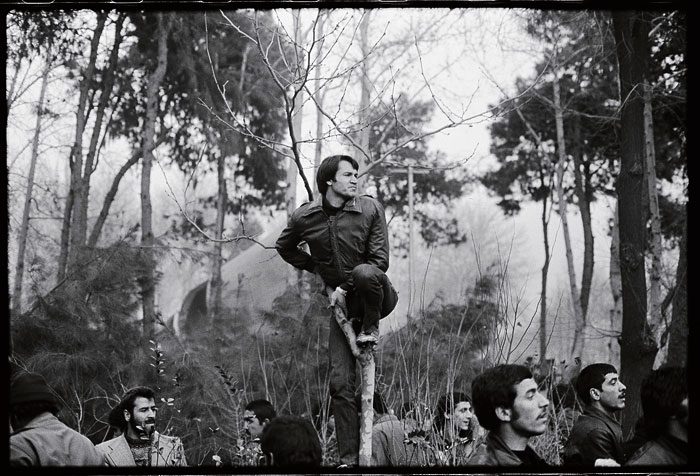
Spectators on Shah Reza Boulevard watch a pro-Khomeini demonstration. Tehran, January 27, 1979
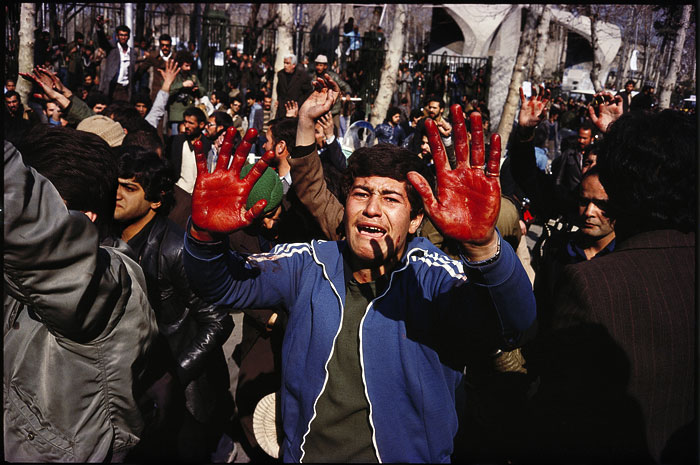
The blood of the latest “martyr” — near the University. Tehran, January 31, 1979
Part Three:
The New Order
February 1, 1979 — February 7, 1979
DAY 38 — FEBRUARY 1, 1979 ...When Khomeini arrives and walks unhurriedly down the steps of the plane onto the tarmac, he’s a distant silhouette. But even at 500 feet, unmistakable. The stern, implacable face of the ayatollah is startling. There’s an undeniable force, a presence, and the Iranian crowd gathered at Mehrabad Airport goes wild. They’re cheering and chanting and moving and running. This is what they’ve been dreaming about, what we’ve all been talking about and waiting for. Now it’s actually happening and here he is. |
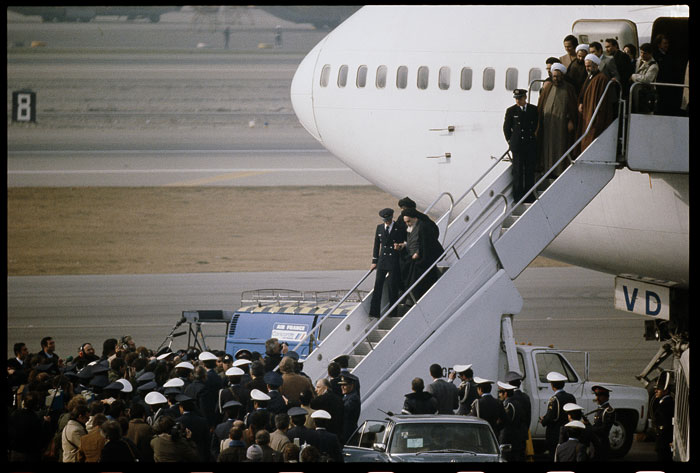
The Ayatollah Khomeini disembarks from an Air France 747 jet at Mehrabad Airport. Tehran, February 1, 1979
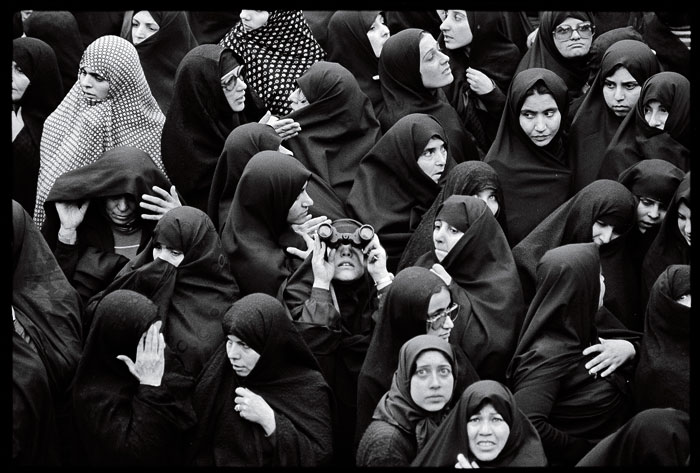
Supporters strain to catch a glimpse of the Ayatollah Khomeini. at the Refah School. Tehran, February 3, 1979
DAY 42 — FEBRUARY 5, 1979 ...“When Imam raises his arm and everybody in the crowd raises their arms, you know, it’s a little bit like Germany in the thirties with the Nazi salute. It doesn’t look so great.” I’m trying to think of anything that will convince him it’s worthwhile for me to make some pictures on the inside. Finally, after three or four days, I spot a little hint of recognition in his eyes. “Let me see what I can do,” he says. He goes off for a few minutes. When he returns he says, “Please, come with me.” |
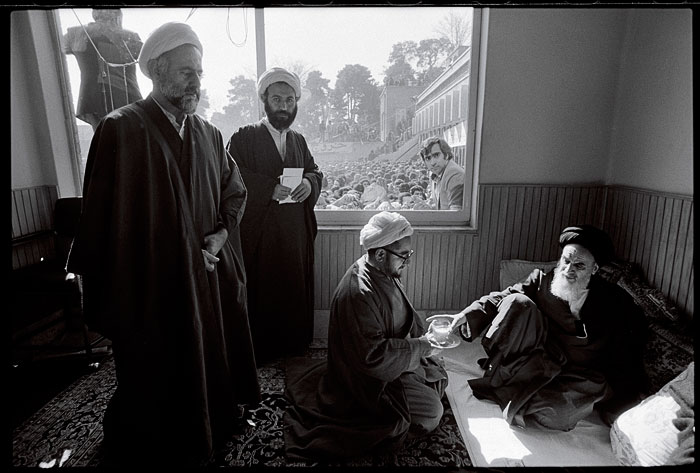
Ayatollah Khomeini in his room at the Refah School. Tehran, February 5, 1979
As we walk in, one of the mullahs is holding a tray to pick up an empty teacup from Khomeini. The ayatollah is sitting on the floor with his back against the wall about eight feet from me. Seeing him up close, the first thing I think is that he actually looks like I thought he’d look. I mean, Khomeini looks exactly like his pictures. I make a couple of quick shots. Then I vaporize, heading for the opposite corner of the small room. Khomeini is cool and calm, speaking in soft whispers to his fellow mullahs. He never makes eye contact with me and I have the impression he doesn’t even know I’m there. |
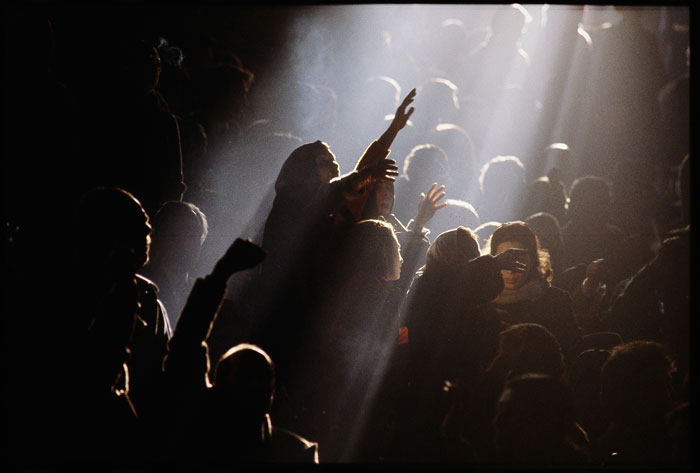
A pro-Bakhtiar demonstration inside a sports hall. Tehran, February 7, 1979
Epilogue:
The First U.S. Embassy Attack
February 14, 1979
Just days after the fall of the monarchy, at about 10 a.m. on Valentine’s Day, February 14, 1979, the fortified U.S. embassy in central Tehran came under a full-scale attack as hundreds of militants clambered over the walls and poured through the breached gate. For two hours, heavy gunfire raged as 19 U.S. marines attempted to protect the compound. The embassy’s defense was handled personally by the ambassador, William Sullivan, who, using a walkie-talkie, eventually ordered the destruction of all classified material and equipment, and instructed the marines to surrender. Amid wafting tear gas, embassy employees were led outside with their hands raised above their heads. Within several hours, men loyal to Ayatollah Khomeini, led by the new deputy prime minister of the revolutionary government, Ebrahim Yazdi, arrived at the embassy and managed to convince the attackers to disperse. Although only one Iranian employee had been killed and one marine wounded, the event both foreshadowed and set the groundwork for the seizure of the American embassy nine months later, following the admittance of the Shah into the U.S. for treatment of cancer. This second takeover, on November 4, 1979, orchestrated by a group of fervent pro-Khomeini students called the Muslim Student Followers of the Iman’s Line, resulted in the capture of 52 Americans and a 444-day hostage crisis. The seizure of the “den of spies,” supported by the Ayatollah Khomeini, led within days to the resignation of the moderate Iranian government of Mehdi Barzagan and, after a failed rescue attempt and the death of the Shah, the defeat of President Jimmy Carter in the 1980 U.S. elections. A watershed experience that significantly damaged American prestige abroad and wounded its collective psyche at home, the crisis emboldened enemies of “The Great Satan”—as Khomeini dubbed the U.S.—and reshaped the course of global affairs. In time its aftershocks would reverberate through conflicts in Lebanon, Afghanistan, Central America, the destruction of 9/11, and the war in Iraq. Thirty years later, effects of the Iranian/U.S. schism continue to be felt throughout the world. |